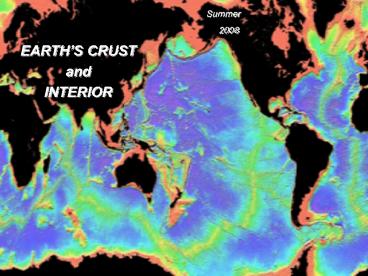EARTHS CRUST - PowerPoint PPT Presentation
1 / 24
Title:
EARTHS CRUST
Description:
Epicenters (map view) indicate plate boundaries. Hypocenters (add depth) map ... different densities, rays are reflected or refracted depending on the angle ... – PowerPoint PPT presentation
Number of Views:70
Avg rating:3.0/5.0
Title: EARTHS CRUST
1
Summer 2008
- EARTHS CRUST
- and
- INTERIOR
2
- HOW DO WE KNOW WHAT WE KNOW ABOUT THE EARTHS
DEEP INTERIOR?
3
- Headlines
- Epicenters (map view) indicate plate boundaries
- Hypocenters (add depth) map subduction zones
- Shadow zones indicate presence of liquids
- Wave arrival times indicate several properties
at depth - density
- elasticity
- boundaries between materials of different
properties
4
- EARTHQUAKES
Earthquakes are the way that Earth releases
stress and passes it on to people. Kate
Hutton An earthquake is a sudden,
violent of movement of the Earth that releases
stored elastic strain In general, materials must
be brittle elastic solids to store and release
energy in this way i.e. materials cannot be
too warm
5
EARTHQUAKE!
6
- Earthquake energy
- The amount of energy released (MAGNITUDE) is
indicated - by the AMPLITUDE and FREQUENCY of the waves
- by the DURATION of shaking
- by the AREA of the fault, and the DISTANCE it
slipped - The magnitude scale is LOGARITHMIC this means
that every increase of ONE POINT on the scale, - means TEN TIMES bigger shaking
7
Aftershocks reveal most detail about fault
extents
They typically occur close to, but not directly
on, the fault plane, and represent the adjustment
of the crust to the sudden movement of the
earthquake
8
RECAP Earthquake epicenters
Epicenter point on ground above the focus
(hypocenter)
9
Wadati-Benioff zones
Earthquakes are seen down to 670 km The bands
of hypocenters point all the way back to the
trench
10
- Hypocenter distribution varies with boundary type
- DIVERGENT (mid-ocean ridges)
- Narrow zones, normal faults
- Shallow earthquakes (above melting depth)
- Usually not of great magnitude up to M6 (thin
weak crust) - TRANSFORM
- Narrow zones, strike-slip faults
- Shallow earthquakes (0-10km in ocean crust,
0-30 in continent) - Up to magnitude 8 (full strength crust)
- CONVERGENT (subduction zones)
- Wide zones, thrust faults
- Shallow to very deep earthquakes (below
melting depth) - (tracks subduction of cold brittle material)
- Up to magnitude 9.5 (Chile, 1960), could be
larger in theory
11
Three types of plate boundary
From Davis et al.
divergent convergent
transform
MELTING reduced pressure water
added none
12
EARTHQUAKE WAVES
13
Seismic wave velocities determined by density and
elasticity at depth
14
Effect of Earths internal structure
Changes in material properties with depth,
i.e. lithosphere asthenosphere mesosphere
outer core inner core
Hypothetical homogeneous Earth
15
Surface Waves
S
P
Rayleigh
Love
Body Waves
16
- SEISMIC WAVES
- P-Waves (body wave)
- Push or Pressure waves (like sound waves)
- Primary or fastest body waves
- Travel through solids and fluids motion
parallel to propagation - S-Waves (body wave)
- Shake or Shear waves
- Secondary or slower body waves
- Travel through solids only motion
perpendicular to propagation - Surface Waves
- Love Waves (horizontal shear motion)
- Rayleigh Waves (vertical motion elliptical
orbits)
17
Locating an earthquake
18
Changes in propagation direction
Reflection
Refraction
19
Refraction and reflection
At a boundary between different densities, rays
are reflected or refracted depending on the
angle This happens for seismic rays as well as
light rays
20
Diving waves
21
S-wave shadow zones
Liquids have zero rigidity S-waves cannot pass
through liquid Thus S-wave shadows suggest the
outer core is liquid
22
P-wave shadow zones
Liquids have zero rigidity P-wave velocity
drops dramatically Thus P-wave shadows suggest
the outer core is liquid
23
- VELOCITY STRUCTURE OF MANTLE
- LOW VELOCITY ZONE
- 100 300 km depth
- Partial melting in Asthenosphere
- VELOCITY INCREASES
- 410 kilometers
- 660 kilometers
- Phase changes in Olivine to denser lattices
24
- Headlines
- Epicenters (map view) indicate plate boundaries
- Hypocenters (add depth) map subduction zones
- Shadow zones indicate presence of liquids
- Wave arrival times indicate several properties
at depth - density
- elasticity
- boundaries between materials of different
properties































